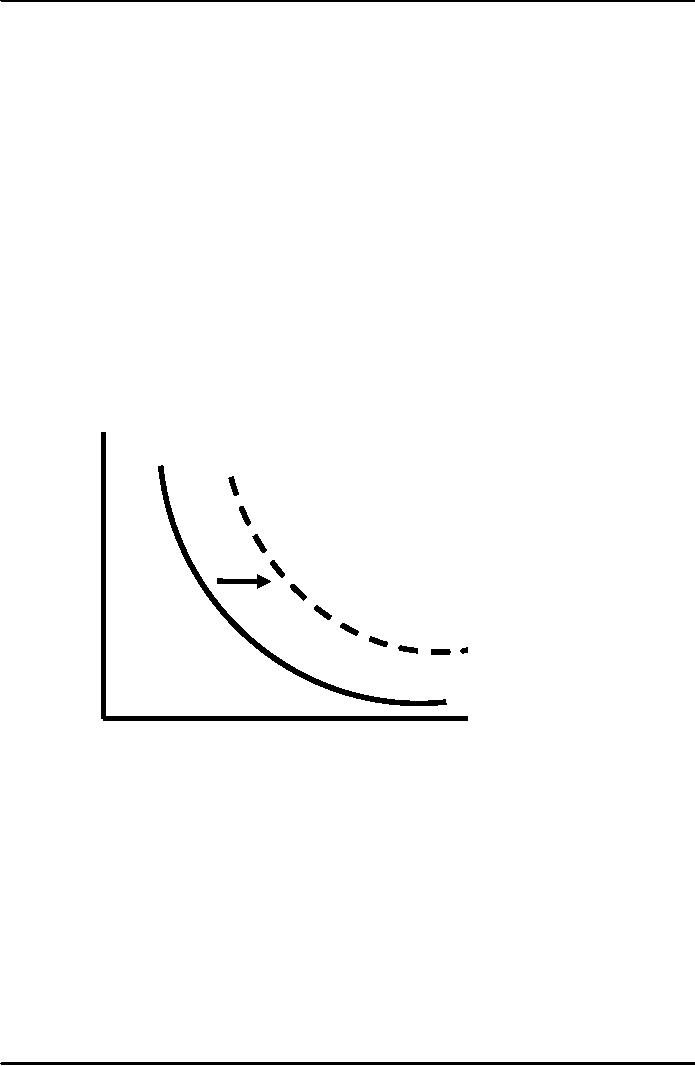 |
INVESTMENT (Continued…):The Determinants of Investment |
| << INVESTMENT:The Rental Price of Capital, The Cost of Capital |
| INVESTMENT (Continued…):Financing Constraints, Residential Investment >> |

Macroeconomics
ECO 403
VU
LESSON
41
INVESTMENT
(Continued...)
The
Cost of Capital
Total
cost of capital = iPK -
ΔPK +
δPK
=
PK (i
- ΔPK/PK +δ)
The
cost of capital depends upon
the price of capital, the
interest rate, rate
of
change
of capital prices and the
depreciation rate.
�
Assuming
price of capital goods rises
with the prices of other
goods, so
ΔPk/Pk =
overall inflation rate,
�
Since,
r
= i - �,
Cost
of Capital = Pk(r
+δ)
�
To
express the cost of capital
relative to other goods in
the economy.
�
The
real cost of capital-- the
cost of buying and renting
out a unit of capital
measured in
terms
of the economy's output
is:
Real
Cost of Capital = (PK /
P) (r +δ)
Where
r
⇒
the
real interest rate
PK / P
⇒ the
relative price of capital.
The
Determinants of Investment
�
Now
consider a rental firm's
decision about whether to
increase or decrease its
capital
stock.
For each unit of capital,
the firm earns real
revenue R/P and bears
the real cost
(PK
/P)
(r+δ).
�
The
real profit per unit of
capital is
Profit
rate = Revenue - Cost
=
R/P - (PK /P)
(r+δ).
�
Because
real rental price equals
the marginal product of
capital, we can write the
profit rate
as
Profit
rate = MPK - (PK / P) (r +δ)
�
The
change in the capital stock,
called net investment
depends on the difference
between
the
MPK and the cost of
capital.
If the MPK
exceeds the cost of capital,
firms will add to their
capital stock.
192

Macroeconomics
ECO 403
VU
If the MPK falls
short of the cost of
capital, they let their
capital stock shrink.
Thus:
ΔK = In [MPK - (PK / P )(r +
δ)]
Where
In (
) is the function showing
how much net investment
responds to the
incentive
to
invest.
The
Investment Function
�
We can
now derive the investment
function in the neoclassical
model of investment.
Total
spending
on business fixed investment is
the sum of net investment
and the replacement
of
depreciated
capital.
�
The
investment function
is:
I
= In [MPK
- (PK / P) (r +δ)] +δ
K
�
This
model shows why investment
depends on the real interest
rate.
�
A decrease in
the real interest rate
lowers the cost of capital.
It therefore raises the
amount of
profit
from owning the capital
and increases the incentive
to accumulate more
capital.
�
Similarly an
increase in real interest
rate raises cost of capital
and leads the firms to
reduce
their
investment.
Real
interest
rate,
r
Investment,
I
I
as r ,hence the downward
slope of the investment
function. Also, an outward
shift in the
investment
function may be a result of an
increase in the marginal
product of capital. e.g.
a
technological
Innovation
�
Finally,
we consider what happens as
this adjustment of the
capital stock continues
over
time.
If
the marginal product begins
above the cost of capital,
the capital stock will
rise and
�
the
marginal product will
fall.
If
the marginal product of
capital begins below the
cost of capital, the capital
stock will
�
fall
and the marginal product
will rise.
�
Eventually,
as the capital stock
adjusts, the MPK approaches
the cost of capital.
�
When
the capital stock reaches a
steady state level, we can
write:
193

Macroeconomics
ECO 403
VU
MPK
= (PK / P) (r + δ)
�
Thus,
in the long run, the MPK
equals the real cost of
capital. The speed of
adjustment
toward
the steady state depends on
how quickly firms adjust
their capital stock, which
in
turn
depends on how costly it is to
build, deliver and install
new capital.
Taxes
and Investment
�
Tax
laws influence the firms'
incentives to accumulate the
capital in many ways.
�
Sometimes
policymakers change the tax
laws in order to shift the
investment function
and
influence
aggregate demand.
�
Here
we discuss two of the most
important provisions of corporate
taxes:
Corporate
Income Tax
Investment Tax
Credit
�
Corporate
income tax is a tax on
corporate profits, and its
effect on investment depends
on
how
the law defines profit
for the purpose of
taxation.
�
Suppose,
at first, the law
says:
Profit
rate = R/P - (PK /P)
(r+δ)
�
In
this case, even though
firms would be sharing a
fraction of their income
with the
government,
it would still be rational
for them to invest if
R/P
> (PK /P) (r+δ)
�
But
in reality the definition of
law is quite different than
this.
Treatment of
depreciation
�
Theoretically:
current value of
depreciation
�
Tax laws:
depreciation at historical
cost
�
The
Investment Tax Credit is a tax
provision that encourages
the accumulation of capital.
It
reduces
a firms taxes by a certain
amount for each unit of
money spent on capital
goods.
�
Since the
firm recoups part of its
expenditures on new capital in
lower taxes, the
credit
reduces
the effective purchase price
of a unit of capital Pk. Thus reducing the
cost of capital
and
raising investment.
Swedish
Investment Funds
System
�
Tax
incentives for investment
are one tool policy
makers can use to control
aggregate
demand.
�
For
example, an increase in the
investment tax credit
reduces the cost of capital
, shifts
investment
function upward, and raises
the aggregate demand.
�
From
mid-50s to mid-70s the govt.
of Sweden attempted to control
aggregate demand by
encouraging
or discouraging investment, through a
system called Investment
Fund
subsidized
investment
�
In
case of economic slowdown,
the authorities offered a
temporary investment subsidy,
and
in
case of economic recovery,
revoked it.
�
Eventually
subsidy became a permanent
feature of Swedish tax
policy.
194
Table of Contents:
- INTRODUCTION:COURSE DESCRIPTION, TEN PRINCIPLES OF ECONOMICS
- PRINCIPLE OF MACROECONOMICS:People Face Tradeoffs
- IMPORTANCE OF MACROECONOMICS:Interest rates and rental payments
- THE DATA OF MACROECONOMICS:Rules for computing GDP
- THE DATA OF MACROECONOMICS (Continued…):Components of Expenditures
- THE DATA OF MACROECONOMICS (Continued…):How to construct the CPI
- NATIONAL INCOME: WHERE IT COMES FROM AND WHERE IT GOES
- NATIONAL INCOME: WHERE IT COMES FROM AND WHERE IT GOES (Continued…)
- NATIONAL INCOME: WHERE IT COMES FROM AND WHERE IT GOES (Continued…)
- NATIONAL INCOME: WHERE IT COMES FROM AND WHERE IT GOES (Continued…)
- MONEY AND INFLATION:The Quantity Equation, Inflation and interest rates
- MONEY AND INFLATION (Continued…):Money demand and the nominal interest rate
- MONEY AND INFLATION (Continued…):Costs of expected inflation:
- MONEY AND INFLATION (Continued…):The Classical Dichotomy
- OPEN ECONOMY:Three experiments, The nominal exchange rate
- OPEN ECONOMY (Continued…):The Determinants of the Nominal Exchange Rate
- OPEN ECONOMY (Continued…):A first model of the natural rate
- ISSUES IN UNEMPLOYMENT:Public Policy and Job Search
- ECONOMIC GROWTH:THE SOLOW MODEL, Saving and investment
- ECONOMIC GROWTH (Continued…):The Steady State
- ECONOMIC GROWTH (Continued…):The Golden Rule Capital Stock
- ECONOMIC GROWTH (Continued…):The Golden Rule, Policies to promote growth
- ECONOMIC GROWTH (Continued…):Possible problems with industrial policy
- AGGREGATE DEMAND AND AGGREGATE SUPPLY:When prices are sticky
- AGGREGATE DEMAND AND AGGREGATE SUPPLY (Continued…):
- AGGREGATE DEMAND AND AGGREGATE SUPPLY (Continued…):
- AGGREGATE DEMAND AND AGGREGATE SUPPLY (Continued…)
- AGGREGATE DEMAND AND AGGREGATE SUPPLY (Continued…)
- AGGREGATE DEMAND AND AGGREGATE SUPPLY (Continued…)
- AGGREGATE DEMAND IN THE OPEN ECONOMY:Lessons about fiscal policy
- AGGREGATE DEMAND IN THE OPEN ECONOMY(Continued…):Fixed exchange rates
- AGGREGATE DEMAND IN THE OPEN ECONOMY (Continued…):Why income might not rise
- AGGREGATE SUPPLY:The sticky-price model
- AGGREGATE SUPPLY (Continued…):Deriving the Phillips Curve from SRAS
- GOVERNMENT DEBT:Permanent Debt, Floating Debt, Unfunded Debts
- GOVERNMENT DEBT (Continued…):Starting with too little capital,
- CONSUMPTION:Secular Stagnation and Simon Kuznets
- CONSUMPTION (Continued…):Consumer Preferences, Constraints on Borrowings
- CONSUMPTION (Continued…):The Life-cycle Consumption Function
- INVESTMENT:The Rental Price of Capital, The Cost of Capital
- INVESTMENT (Continued…):The Determinants of Investment
- INVESTMENT (Continued…):Financing Constraints, Residential Investment
- INVESTMENT (Continued…):Inventories and the Real Interest Rate
- MONEY:Money Supply, Fractional Reserve Banking,
- MONEY (Continued…):Three Instruments of Money Supply, Money Demand